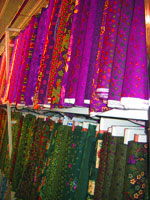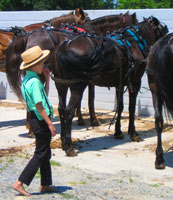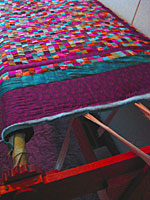
In the previous article we detailed steps to making your own Amish quilt. Making an Amish quilt is time consuming but the finished product is a reward that can be kept as a heirloom or given to a loved one. The following steps will be covered in this article.
Assembling your Amish quilt top Choosing the quilt batting Assembling the Amish quilt sandwich Binding the quilt Hand quilting and machine quilting.
Assembling your Amish quilt top
Once all of your blocks have been sewn together, it is time to make the quilt top. Quilt blocks are usually put together by sashing. Sashing is using fabric strips to create a border around the blocks and break the pattern so that the eye can focus on each blocks design for your Amish quilt.
After you have cut each piece of sashing, attach it to the blocks in the same way that you previously assembled all the squares. It is easier sometimes to use long strips than using smaller strips and having to sew them all together.

Measure often when using pins to secure your sashing to the blocks and use the right angle of the fabric to line up the seams. This will help assure that your Amish quilt is in geometrical order.
Choosing your quilt batting
The batting for the quilt is the weight of the quilt and is the middle of the quilt sandwich. Batting comes in different degrees of texture, composition and thicknesses. The types of batting vary from man made fabrics to natural fibers.
Wool - Warm and good at absorbing moistures, wool is used in wet and cold climates. Once quilted, it looks nice but it is flatter than unnatural fibers. Wool has certain washing and “care for” needs to be sure and look up how to take care of your wool Amish quilt so that it does not get damaged and lose its look. Polyester - Lightweight and inexpensive, polyester packs well and will give your quilt more of a puffy looks. It does have a tendency to “bears”; which means it will work its way out of the fabric weave. Cotton - A good choice for beginners and those wanting to stay with the authenticity of the Amish quilt, cotton is easy to work with and natural.
Assembling the quilt sandwich
The first thing to do when assembling your Amish quilt sandwich is to make sure you have an area that offers a lot of space that will not be disturbed. It is not recommended to do this in the floor, because of how much bending you will have to do before you have your sandwich completed. One idea is to buy a large piece of MDF and lay this on your kitchen table while working and then it can be moved without disturbing your progress.
The first step is to lay out your backing and make sure it is smoothed out and without wrinkles or puckers. Next lay your batting and center it, leaving even amounts of material around all the edges. Finally add the quilt top, being careful to get it in the center, keeping even distances from the backing and batting edge. You may need to trim a little bit back if your batting is large, but make sure your batting still larger than the backing. Next you will need to pin the quilt sandwich. Place a pin in the center of the sandwich holding the three sections together. 6 inches along pin the next spot and then the next. You will need to work your way out so it keeps your Amish quilt flat and free of excess fabric.
Binding the Amish quilt
This step means that your Amish quilt is almost finished. There are several different ways to bind the edge of your quilt.

One way is to use a strip of material as binding that coordinates with the colors or pattern of you quilt top. In order to do this you will need to cut your strip of material/binding to about ½ inch wider that what you want the width to be. Fold the material/binding in half with the back of the material together and iron it flat. Fold your edges again and iron. Then line up the fabric edges with the top raw edge of the quilt with the pressed and folded edges facing the center of the quilt. Then sew the raw bound edges to the raw quilt edge about 1/4 inch away from the edge. Then fold the bind over the back side of the quilt and bind stitch to the back covering all the raw edges. You can use an overlap of material either from the quilt top or the backing. Fold the excess over the raw edge, turn under the edge of the binding and stitch it down. This process is not as strong as using separate bindings, so if the Amish quilt is for everyday, consider doing it a different way as the edge of your quilt receives the most use. This method of binding is simple and easy however might not give your Amish quilt the same look as so many Amish quilts.
Hand quilting or Machine quilting
Hand quilting the Amish way is by far the most time consuming, but authentic way to stitch your Amish quilt. One of the most important things to remember is that regardless of if you are doing appliqué or patchwork, you must start your stitches in the center of the quilt. Do not rush and make small stitches in order for the quilt to not look sloppy. When you are sewing, start 1-2mm away from the shape as this will help accentuate the shape.
Machine quilting is by far easier and faster than hand quilting. There are many different types of stitches now offered by quilting machines giving you a flexibility that was not offered before on pattern stitching. The argument is that the irregularities of hand stitching is what makes the Amish quilt unique and gives it heirloom charm.
